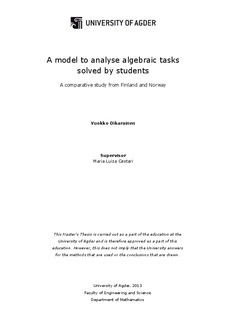| dc.description.abstract | Participating in the international VIDEOMAT-project, which is accomplished by four universities from Finland, Norway, Sweden and California (USA), this master thesis has beenbased on a comparative study about the introduction of algebrain Finland and Norway. The focus of the present study has beento compare the way studentssolve algebraic tasks: theprocedures which they use while solving tasks and the mistakes they produce. Similarities and/or differences have beenidentified between those two countries.
The empirical material for thisresearch has already been collected and it includes videotaped lessons, lesson graphsand students’ written work. The focusis on the comparison of the students’ written work. The empirical material comes from four classrooms both in Norway (7thand 8thgrade) and in Finland (6thand 7thgrade) when students are at the same age, 12–13 -year-old. This material have included 110 notebooks or testsof students: everystudent has solved approximately 11 tasks during the data collection. The micro analysis has been done and procedures and mistakes of all solution processeshave been analysed bythe model which has been created during the study. The findings have been presented as tables in which different students’ procedures and mistakes of someanalysed tasks are visible.
The findings have shownthat the Finnish students are using more similar procedures among themselves while solving tasks than the Norwegian students. The identified mistakes are mostly related to the minus sign, equal sign and writing expressions. Related to the procedures, the Finnish students are supposed to presenttheir working while solving thetasks, for example,with review of calculations. The Norwegian students have presented more atypical, but correct, solutions than the Finns. Boththe Finnish and Norwegian students have difficulties with the minus sign and equal sign but in the context of writing expression the Finnish students have had difficulties to connect algebra and geometry while the Norwegian students had problems in writingan expression from the writteninstructions.
As a conclusion, the understanding ofarithmetic operations is problematic in both countries. Students, for example,have presented mistakes related to the simply calculations with the minus sign. As a didactical implication, the connectionbetweenalgebra and other fieldsof mathematicsshould be more strengthen to promote a deep and meaningful understanding of mathematics.
Key words: algebra, tasks, comparative study, Finland, Norway | nb_NO |
